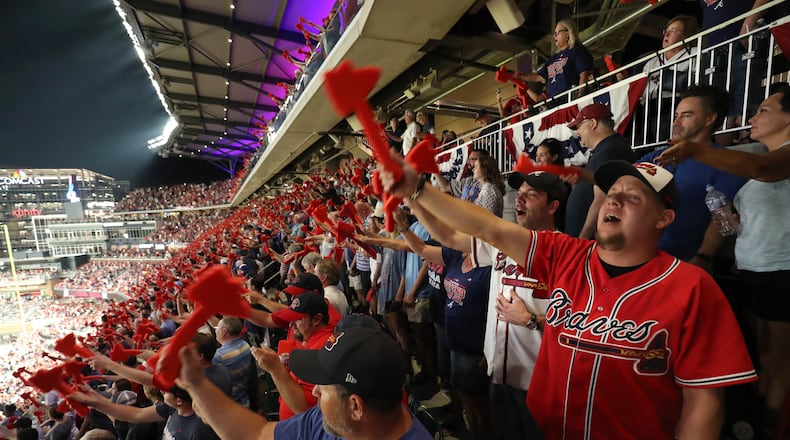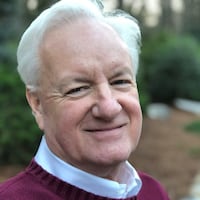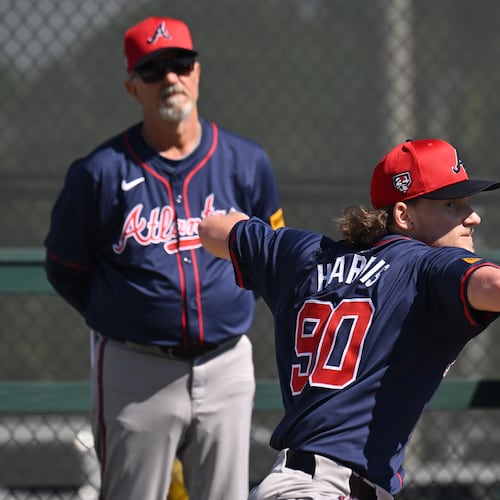Announcements by the Washington Redskins and the Cleveland Indians that they will consider name changes have raised questions about whether the Atlanta Braves will do likewise.
The team’s top executive, Terry McGuirk, has an unambiguous answer.
“We are so proud of our team’s name, and our expectation is that we will always be the Atlanta Braves,” said McGuirk, the Braves’ chairman.
“I would say unequivocally the Atlanta Braves’ name will stay the Atlanta Braves,” McGuirk added a few minutes later. “We come to that position as a result of … a lot of listening to our fans, to the Native American community. We have spent the last six months trying to make sure we are grounded in everything we say going forward, so I would again answer the question: Yes, we will be the Atlanta Braves.”
McGuirk and Braves President and CEO Derek Schiller discussed the team’s name and related issues, including the tomahawk chop by fans and the tomahawk logo on game jerseys, in an exclusive hour-long interview with The Atlanta Journal-Constitution.
REMAIN OR RENAME BRAVES?
» Why bring up Braves name now? » Mark Bradley: How about 'Atlanta Brave?' » Poll: Fans overwhelmingly support keeping name » Fan's view: What to tell son, honoring culture » Fan's view: Storied history matters » Fan's view: Keep community, change name
The executives said the tomahawk will remain on the Braves’ jerseys, but were noncommittal about the future of the chop at Truist Park.
“The brand goes along with the name,” McGuirk said. “The tomahawk logo on the jersey as a big piece of our iconography is here to stay. We are proud of it. We think our constituencies hold it in an equally high level of esteem.”
The team’s position on the tomahawk chop at games is a different and unresolved question, the executives said.
“At this point in time, those discussions are still ongoing,” Schiller said. “… It’s a topic that deserves a lot of debate and a lot of discussion and a lot of thoughtfulness, and that’s exactly what we are doing.”
“Let’s state the obvious: We didn’t invent the chop,” McGuirk said. “It came with (former Braves player) Deion Sanders when he arrived from Florida State. Our fans adopted it. It became a symbol of our fans’ excitement when we were doing well, when there was a crescendo in the game, and frankly we have all been amazed by how it has taken off and the longevity of it as a piece of our lore now. So it is important to our fans.
“When we have to consider (the issue), we have a much wider group to sort of spread that consideration over. And it is taking a little longer. But be assured we are spending a lot of time thinking about it.”
The tomahawk chop has been a part of Braves home games since 1991 and has been encouraged and promoted by the organization through the years. It has been under review by the team since St. Louis Cardinals relief pitcher Ryan Helsley, a member of the Cherokee Nation, criticized its use during last year’s National League Division Series. In an interview with the St. Louis Post-Dispatch, Helsley called the chop and chant “a misrepresentation of the Cherokee people or Native Americans in general” and said it depicts them as “caveman-type people” who “aren’t intellectual.”
The Braves responded to Helsley’s comments by deciding not to distribute 40,000 foam tomahawks at the series’ final game and not to play the musical prompt for the chop and chant if Helsley was in the game. He didn’t get into the game, which the Cardinals won 13-1 after scoring 10 runs in the first inning, and the chop was prompted several times.
The Braves said at the time they would evaluate the tomahawk chop during the offseason and continue dialogue about it. But nine months later, they haven’t announced a decision.
“We’re still listening and learning and trying to make the best decision possible,” Schiller said, “taking into account our team and what (the chop) does to help our players in competition, our fans and … what Native American communities think of this. All of those things packaged together, we’re trying to make the right decision.”
Schiller said the COVID-19 pandemic, which shut down the Braves’ offices for several months, delayed a decision. The Braves are scheduled to play their first home game of the pandemic-delayed season July 29 without fans in attendance.
Asked if the decision on the chop will be deferred until 2021, Schiller said: “I suppose it depends on whether there are fans in the ballpark (at some point) in 2020, and there is still hope we’re going to have fans in the ballpark. That is something that would clearly bring on a need to bring that discussion and topic to conclusion.
“No matter what the decision is from our vantage point,” Schiller said, “this started as a fan initiative, and the fans are likely going to keep doing it anyway.”
Schiller said the issues of the tomahawk chop and the team name “are definitely different from one another.”
The Braves franchise was known by various other names in the late 1800s and early 1900s in Boston: the Red Stockings, Red Caps, Beaneaters, Doves and Rustlers. The team was renamed the Braves in 1912 and known by that moniker until 1936, when the name was changed to the Bees. The team returned to Braves in 1941, and that name followed the franchise as it moved from Boston to Milwaukee in 1953 and from Milwaukee to Atlanta in 1966.
There hasn’t been a serious move in the Braves’ Atlanta era toward changing the name, although there was a fleeting mention by new owner Ted Turner in 1976 of renaming the team the Eagles. Turner’s reasoning was that the Eagles name would tie in with the city’s other bird-named teams, the Falcons and Hawks. But he quickly dropped the idea.
“I’m proud of the heritage. I’m proud of its history,” McGuirk said of the Braves name. “Any brand, any name, is basically a representation of what goes on underneath it. I think this franchise has conducted itself in an honorable way throughout all of that history.”
Schiller said the Braves name, to him, “means somebody who possesses courage, is a warrior. So for me, it’s held in high regard and it’s esteemed by the Native American culture and it’s powerful. It’s very representative of strength and honor.”
Schiller declined to compare the Braves’ case to the Redskins’ or Indians’, saying: “I don’t think we can speak to those (teams’) situations.”
The Redskins organization announced July 3 that it would “undergo a thorough review” of its long-criticized name, and the Indians quickly followed with a commitment “to determine the best path forward with regard to our team name.” The Redskins’ announcement came after major sponsor FedEx called on the team to rename itself.
Schiller said the Braves’ sponsors have been “extremely supportive.”
Since the end of the 2019 season, McGuirk and Schiller said, the Braves have sought advice on the tomahawk chop and other issues from a Native American Working Group the team assembled and from others. Schiller said he visited leaders of the Eastern Band of Cherokee Indians in North Carolina.
“Their school in Cherokee, N.C., is the Braves,” Schiller said, referring to the nickname for the sports teams at Cherokee High School. “They brought that up. ... It was really cool and nice to see that.
“I think we have done a really earnest job of going out there and trying to understand the Native American communities and what’s important to them, what types of things they see that they want to do with the Atlanta Braves. ... We are very serious about it. We are extremely excited about the prospects for the future and what they hold for our relationships.”
The Braves plan to build an exhibit at Truist Park celebrating Native American culture, likely in the Monument Garden area behind home plate, Schiller said. The team also plans to partner with a foundation to provide educational programs about the culture for junior high and high school students, he said.
“We feel really comfortable with the level of collaboration that has taken place over the last year,” McGuirk said.
About the Author
Keep Reading
The Latest
Featured



